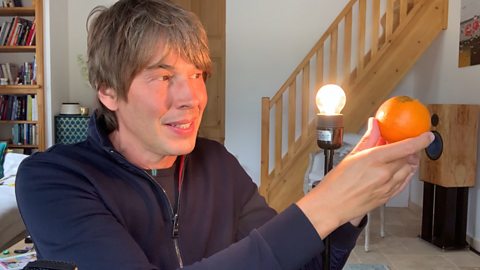What is our galaxy, the Milky Way, made of?
Well, that is a really good question.
I suppose the obvious answer, and it's right in part, is stars - some smaller than the sun and some bigger than the sun.
There are around, well between 200 billion and 400 billion stars in the Milky Way galaxy and the majority of those have planets orbiting around them - solar systems of their own.
But all that mass, all those hundreds of billions of stars is only a very small fraction of the mass of our galaxy.
There is more gas and dust in the galaxy, by mass, than the material contained in the stars - about a factor of two more. So our Milky Way is more dust and gas than stars.
But even if you put all that material together, that is still a very small fraction of the Milky Way galaxy.
The majority of our galaxy is made up of something called dark matter. That's a mysterious substance. We don't yet know what it is.
We strongly suspect it's some kind of subatomic particle, so things like the electrons that go around the nucleus of an atom, but with different properties that interact very, very weakly indeed with the material in the stars and planets and indeed, with the material that makes up you and me.
So, I don't want to give you numbers because this is the cutting edge of physics. These things are changing all the time, but I'll give you a rough estimate.
So as of now, in 2020, we think that something like 5 percent of the mass of our galaxy is made up of the stars that we see shining in the sky.
Around 10 percent is made up of dust and gas.
And something like 85 percent, perhaps more, of the mass of our galaxy is made up of dark matter and we don't yet know what that is.
This video explains what a galaxy is, using the Milky Way as an example.
It explores the composition of a galaxy, emphasising that stars, dust and gas make up only a tiny fraction of the total space.
The concept of dark matter is introduced: what we currently believe dark matter to be and its estimated proportion of the galaxy.
The video demonstrates that science does not have all the answers regarding the Milky Way, and that research into dark matter is the cutting edge of contemporary science.
Teacher notes
Points for discussion
Terminology in space physics can be challenging and students often find it difficult to appreciate the relationship between terms like stars, planets, the solar system and galaxies. This clip helps to reinforce the meaning of a galaxy, using the Milky Way as an example.
Many students will have preconceptions about what dark matter is, based on science fiction and popular culture. It is important that students appreciate that scientific knowledge increases over time with research and investigation, and that scientific theories and ideas change as more is understood. The continually developing ideas about dark matter - what it is and what proportion of the galaxy it occupies - is a good example of such cutting edge science.
Suggested activities
This video could serve as an introduction before students start learning about the composition of stars and how the sun was formed at KS4.
After watching the video, students could research how scientists gather information about stars and galaxies. Alternatively, at KS3 or KS4 they could suggest their own questions about dark matter and investigate them.
Curriculum information
Suitable for KS3 England, Wales and NI and CfE Scotland, S1-3 Combined Science and Physics GCSE in England, Wales and Northern Ireland and at National 4 and 5 in Scotland, and Cambridge IGCSE Physics.

Why do we have days, nights and seasons? video
A demonstration, using everyday objects, of how the Earth moves to give us days and nights, and seasons.

Why do astronomers use 'light years' to measure distance in space? video
A short explanation of âlight yearsâ and why scientists use them in place of standard units of measurement when talking about space.

Moons in our solar system. video
A short description of moons in the solar system including what differentiates a moon from a planet.

The solar system. video
A description of the solar system including the eight planets, the asteroid belt, dwarf planets, the Kuiper Belt and the Oort Cloud.
